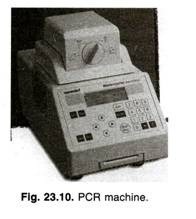ADVERTISEMENTS:
Different classes of SPs are shown in Fig. 14.4. Much is unknown about the HSPs in the range of 100-110 KD and above.
Newer information is gradually accumulating in literatures about their roles in normal cellular processes.
Critical insight on the functional features of this class during heat stress and thermotolerence are yet to appear.
It is stated that 110 KD HSP is a constitutively expressed protein in eukaryote. Its synthesis increases about five folds after stress conditioning. It is unclear about its involvement in resumption of normal nuclear transcription events during recovery from the heat insult.
The synthesis of the protective heat shock proteins produced by eukaryotes in response to high temperature is regulated by the 110 KD heat shock transcription factor (HSTF). Foot-printing study results have shown that this protein specially binds to a conserved partially palindromic segment (consensus sequence CNNGAANNTTCNNG) upstream of many known heat shock coding sequences HSTF like sp1.
Also, when bound to its target, sequence stimulates the transcription of the associated gene. While protecting some regions of DNA from DNAse 1 digestion, HSTF also renders portions of its bound DNA hypersensitive to this enzyme. The grp 100 KD exhibits considerable sequence homology with HSP 90, a cytosolic protein.
The HSP 90 group is one of the most abundant cytoplasmic proteins present in most types of cells even under non-heat shock conditions. This group may exist in two forms, e.g., HSP 90 α and HSP 90β. The two forms differ slightly in molecular mass and have been identified in mammalian cells. They are encoded by distinct genes which are regulated differently during normal development.
ADVERTISEMENTS:
Also, they form transient associations with various regulatory and structural proteins including viral oncogene products having tyrosine kinase activity. This associative capacity of HSP 90 indicates them to be regulatory molecules. Their additional accumulation may inhibit inappropriate activation of regulatory cascades during metabolic perturbations caused by hyperthermic and other stresses.
The classes of HSP 70 proteins are reported to bind ATP and cause promoter activation. They may have origin from cytoplasm, mitochondria, and endoplasmic reticulum organelles. They are believed to participate in energy-dependent processes such as the disassembly of the clathrin coat of the vesicle, ATP reversible binding of various abnormal proteins, and translocation of proteins across membranes.
The HSP70 family of cytoplasmic origin appears to bind directly to nascent polypeptide chains associated with ribosomes during the process of elongation. It is speculated that HSP70 proteins can reversibly interact with internal regions of preexisting proteins that are exposed as the result of thermal denaturation during heat stress and facilitate correct refolding.
They may also help reassembly of multi-protein structures damaged by heat. These proteins accumulate in the nucleus primarily in association with the regular region of nucleoli, the location of ribosome assembly. Ribosome assembly, on the other hand, is extremely sensitive to hyperthermia and preaccumulation of some HSP70 in mammalian cells. It is reported to accelerate recovery of nucleolar morphology following heat stress.
It is now known that expression of the human HSP 70 gene in the cell cycle regulates and is inducible by both serum and adenovirus Ela protein. This regulated expression is predominantly controlled by the CCAAT element at position- 70 relative to the transcriptional initiation site.
Its corresponding CCAAT binding factor (CBF) of 999 amino acids cloned recently has been stated to stimulate transcription selectively from the HSP70 promoter in a CCAAT element-dependent manner. A more recent publication reports that 192 residues of CBF, when fused to the DNA binding domain of heterogeneous activator GAL-4, are necessary and sufficient to mediate Ela-dependent transcriptional activation.
It could show Ela and CBF to exhibit complex formation in vitro. It suggested that an in vivo interaction between these proteins may be relevant to the well- characterized Ela-induced transcriptional activation of the HSP70 promoter.
The major bacterial HSPs belong to HSP60 class. These are homologous to the E. coli groEL gene product. This class is also required in bacteriophage assembly and host DNA replication at normal temperatures. This may be associated transiently with newly synthesized unfolded polypeptides.
This class of protein is encoded by a nuclear gene and has site in mitochondria. It is synthesized at elevated levels after shock. During protein import, cytoplasmically synthesized mitochondrial proteins are initially recognized by a mitochondrial form of HSP70 and then passed onto a HSP60 complex upon which final folding and assembly occurs.
ADVERTISEMENTS:
The diverse group of small stress proteins has a multiple size range (molecular weight 15 to > 30 KD). In this group charge variants have been stated to exist in lower to higher organisms. In mammalian cells a single small HSP27 has been known to have multiple isoelectric forms.
The small HSPs have been reported to associate with mRNA during stress in insect and plant cells. Rapid phosphorylation has been demonstrated in human HSP27 in response to heat shock treatment. It is likely that small HSPs play a role in both growth signal transduction and thermotolerence. So far little is known about the nature and function of HSP27 as well as other small HSPs. In many instances functional characteristics of HSPs of prokaryotes are shared by their counterparts in eukaryotes (Table 14.1).

